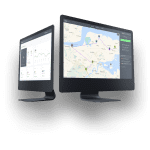In e-commerce, achieving success hinges on ensuring swift and reliable deliveries. Herein lies the importance of route optimisation. E-commerce route optimisation involves strategic planning and organisation of delivery paths to pinpoint the most efficient ones. It’s about devising the smartest approach for mapping routes from point A to point B, ensuring every mile and second are utilised optimally.
Effective ecommerce route optimisation transcends being just a logistics tool; it acts as an accelerator for business expansion. Ecommerce entities gain a dual benefit: first, enhancing delivery efficiency by swiftly getting products to customers; second, boosting sales prospects through satisfied customers who return and advocate for the business through positive referrals.
Lastly, we will explore how ecommerce route optimisation influences the management of deliveries, its effect on customer loyalty, and its ability to enhance delivery tactics to boost sales.
Factors impacting eCommerce route optimisation
Several factors can affect route optimisation while creating an efficient and seamless route for eCommerce courier deliveries. Some of the critical factors are:
1. Distance
Distance plays a crucial role in influencing route optimisation. By reducing the travel distance through optimisation, fuel consumption is decreased. Ecommerce businesses, by adhering to these optimised routes, can ensure their vehicles operate with utmost efficiency.
2. Traffic
Traffic congestion presents a significant challenge for businesses during deliveries. This issue can be addressed by incorporating real-time traffic information into the route planning, preventing avoidable delays and guaranteeing timely deliveries. Additionally, advanced route optimisation algorithms can dynamically alter routes, aiding in adhering to delivery schedules.
3. Delivery windows
Ensuring adherence to delivery windows is vital for total customer satisfaction. Efficient route optimisation can prevent missed deliveries or delays. Furthermore, organisations can enhance their reputation and build trust with clients by consistently providing timely deliveries.
4. Vehicle capacity
Intelligent route planning takes vehicle load limits into account in delivery scheduling. Thus, it reduces trip frequency, reducing operational costs linked to multiple journeys and higher fuel consumption. Achieving an optimal balance
between cargo load and travel distance enhances efficiency and cost savings.
Effective eCommerce route optimisation strategies
Successful route enhancement is essential to guarantee that conveyances are productive and consistent. Some strategies can assist eCommerce businesses in their route optimisation game and thus avoid eCommerce shipping delays.
1. Dynamic routing
Adjustments to routes in real-time must respond to weather, traffic, and order modifications. Dynamic routing maintains flexible and responsive delivery plans, reducing delays and enhancing customer satisfaction.
2. Batch delivery
Efficient multi-drop deliveries are attainable by clustering orders based on their proximity or designated delivery times. This approach reduces unnecessary stops and route retracing, streamlining delivery paths and maximising efficiency and time savings.
3. Time management
Assign a distinct delivery slot for each route to align with customer preferences. Organisations can reduce congestion, enhance dependability, and meet client requirements by scheduling deliveries in peak and off-peak hours.
4. Driver training
Providing drivers with training and route optimisation tools prepares them for efficient travel. Drivers can relay real-time information to the dispatch centre through open communication channels, facilitating swift route adjustments and optimal fleet management.
5. Geographical locations
Identify manageable areas within delivery territories. Assigning drivers to designated zones enables them to familiarise themselves with specific routes, traffic behaviours, and unique delivery aspects. This segmentation reduces delivery durations and enhances drivers’ understanding of their allocated areas.
6. Data analysis
Consistently gather customer feedback and review delivery data. Insights from these sources can identify areas for enhancement, allowing companies to refine their route optimisation strategies and continually elevate the delivery experience.
By trying these strategies, eCommerce business organisations may further improve their delivery courses, encourage a customer-driven outlook, reduce costs, and advance long-haul development in a market that is becoming increasingly severe.
Why efficient eCommerce route optimisation matters
This segment will determine how effective course streamlining will benefit eCommerce businesses. So we should get started:
- Route optimisation can help to save a significant amount of money in terms of fuel or vehicle maintenance costs. eCommerce businesses can use optimised routes to reduce the distance travelled and time spent on the road, thus lowering the overall operational costs.
- Route optimisation aids in estimating the time of arrival (ETA), impacting buyers’ purchasing decisions. These optimised paths guarantee timely deliveries, thereby enhancing customer satisfaction.
- Route optimisation contributes to environmental sustainability by decreasing travel distances and fuel usage. It accomplishes this by reducing carbon emissions via shorter routes and avoiding congested traffic areas.
- Route optimisation enhances operational productivity, enabling drivers to perform more ecommerce deliveries in a shorter timeframe. This efficiency boost positively influences customer satisfaction and business profitability and avoids eCommerce delivery issues.
- Route optimisation provides valuable insights and data for navigation and ongoing refinement. This information includes delivery timings, fuel consumption, and driver performance metrics.
These were some of the significant benefits of optimising eCommerce routes.
eCommerce delivery trends
To stay ahead in the competitive market, eCommerce businesses must adapt to the following future trends:
Eco-friendly deliveries
Eco-friendly shipping involves using biodegradable materials for packaging and shipping products, ensuring they can be easily recycled and decomposed. This approach also includes shipping methods that produce low carbon emissions, consolidating orders into single shipments, and adopting effective strategies to reduce parcel delivery’s ecological impact.
Showing dedication to environmental health with sustainable packaging practices can boost your brand’s image and build customer confidence.
AI and machine learning
Artificial intelligence and machine learning are emerging trends enhancing route optimisation’s effectiveness. These technologies enable route optimisation algorithms to process vast data, learn from historical patterns, and adapt to real-time scenarios. This powerful approach refines delivery routes by considering traffic, weather, and order volumes, ensuring precise predictions and timely adjustments.
Use of drones
A rising trend in executing last-mile deliveries is the adoption of drones. These automated flying vehicles ensure rapid, last-mile delivery in urban areas, bypassing ground traffic congestion. As drones become increasingly autonomous and capable of navigating intricate environments, they are poised to revolutionise the pace and reach of delivery services.
Internet of Things (IoT)
The Internet of Things (IoT) is another trend for route optimisation. Organisations can screen vehicle conditions, track areas, and accumulate continuous information by outfitting vehicles with sensors and networks. This data impacts proactive upkeep, boosts driver security, and adjusts routes for ideal proficiency.
As these trends merge, the eventual fate of route optimisation in web-based business guarantees another era of accuracy, speed, and consumer loyalty.
Courier optimisation software
Courier optimisation management software enables couriers to deliver their packages faster without burdening their drivers and resources.
Couriers are often expected to drive hundreds of kilometres or miles daily, ensuring packages arrive in good order and as fast as possible. Couriers who cannot do this will undoubtedly lose out.
To meet customer demand, your courier company needs a technology solution that delivers faster routes without delays, errors, or additional costs.
eCommerce route optimisation drives sales
In the rapidly evolving sphere of ecommerce, excelling in route optimisation transcends logistical needs, playing a crucial role in enhancing customer experience and fostering business growth. Through innovative technologies, online business firms can improve delivery effectiveness, fulfil customer needs, and discover new avenues for revenue generation.
Developments in artificial intelligence, drone integration, and IoT technologies are set to revolutionise route optimisation, offering fresh prospects to surpass competitors as we look ahead. By embracing these trends and technologies, businesses can remain at the forefront of innovation and customer focus.
Embracing advanced route optimisation is more than just mapping paths; it’s a stride towards advancement in the ever-changing ecommerce landscape.
Check out our route optimisation software comparison for 2024.




